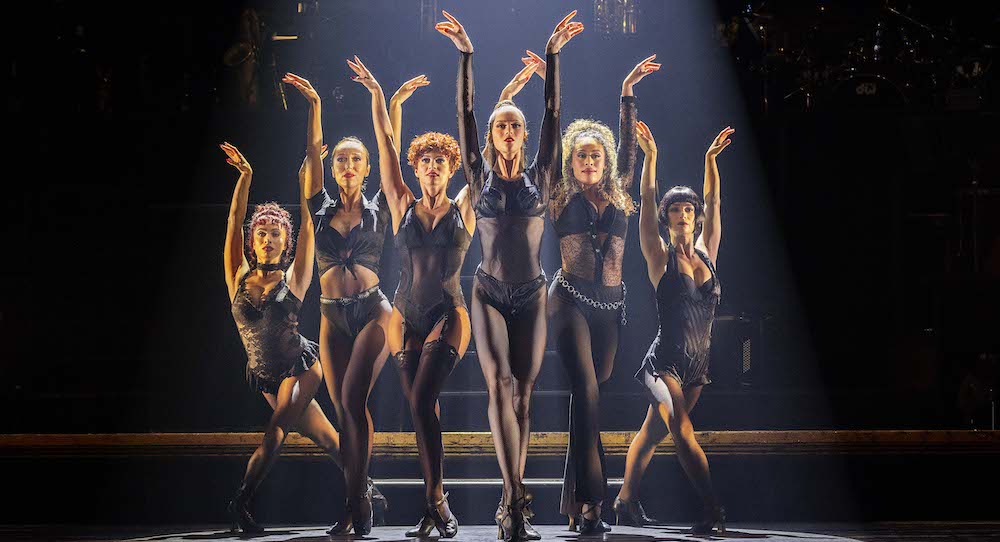Capital Theatre, Sydney.
13 June 2024.
Chicago opened to standing ovation in Capitol Theatre Sydney this week. This iconic musical, written by John Kander and Fred Ebb, returns to the stage this winter for a wonderful night out at the theatre. Lauded in its time as “the finest piece of stage satire ever written by an American” (W W O’Brien), Chicago is a mostly true, slightly fictional telling of a story revolving around two women and their fellow jailbirds, who play into the sensationalism of 1920s journalism and societal fascination with the stories of these infamous murderesses. It is cabaret style in structure, with live jazz band on the stage, and big, well-known numbers that have the audience sitting on the edge of their seats wanting to join in the sensational rhythms and swooning vocals.
The legendary Bob Fosse choreography that shaped this show is always a treat to behold. Known for his exacting standard and finicky details, Fosse’s gestural and angular choreography, when executed well gives the gift of looking simple to the audience, all whilst being incredibly difficult to unwrap for the dancers. Fosse’s penchant for perfectionism is legendary. The cast had a mixture of success with the execution of the distinctive style. Lines were not perfected to become one in the group numbers, and the details were often lost and awkward. The pictures created should have been so clear, yet they were often blurred, cut short and messy. The spectacular nature of Fosse work that is in the details, was often lost. Unfortunately, there did not seem to be the depth of understanding of the details, consistent throughout the performance. Special mention, however, should be made of ensemble member Sarah Heath, who stood out in her excellent execution of the choreographic detail and embodiment of all things Fosse, no small feat for a professional debut. She oozed ’70s sensuality, the era from which this show was born, whilst being clear and precise in her movement.
The cast shone in their ability to make this work relatable and fresh, in many little moments threaded throughout. Lucy Maunder as Roxie Hart brought her own to the role, with sass and pizzaz, playing the narcissistic attention-seeker to a tea. Maunder was able to keep the 1920s cutesy vibe whilst adding in a modern grounding to her portrayal, bringing to the fore a sense of today’s obsession with media and self-promotion. The emptiness of it all ran true in Maunder’s portrayal, gutsy vocals, and on-point acting. Zoë Ventoura as Velma Kelly brought sass, excellent facial dexterity, lovely vocals, comedic timing, but lacked the command of the space that this role requires. Her energy often fell off the edge of the stage, and her execution of the choreography was average. There is a diamond in that rough in Ventoura as a theatrical performer, that hopefully as the season goes on, she is able to shine, and her portrayal of this role becomes something special.
It was a treat to see Anthony Warlow grace the stage as Billy Flynn, effortlessly charming his way through as the confident and sly lawyer. His rat pack-esque vibe was a perfect interpretation for this role. Peter Rosthorn as the usually boring and uninspired Amos Hart character, was a little gem in this production, his Chaplin inspired movement and embodiment of the invisible, melancholy Pierrot-like character was a highlight. He made a usually very unexciting character, quite interesting. Asabi Goodman as Matron ‘Mama’ Morton brought incredibly strong vocals, but lacked the staging that is usually a feature in this character, really letting her performance down.
The ensemble had some strong members, including rising theatre star Angelique Cassimatis, Hayden Baum, Devon Braithwaite, Olivia Carniato, Todd Dewberry, Louis Fontaine, Sarah Heath, Chaska Halliday, Matthew Jenson, Ethan Jones, Tom New, Nathan Pinnell, Rania Potaka-Osborne, Priscilla Stavrou and Romina Villafranca, who in particular oozed Fosse vibes. Villafranca was brilliant, and true to era. As a whole, the ensemble had strong vocals, and brought good energy to the show.
Costumes were simple, along with the set pieces, the quintessential 1920s influenced burlesque style, with a hint of the ’70s thrown in. The band were not dressed in style, though, just simple stage blacks, and this let down the mise-en-scène. Being on stage the entire show does not necessarily require attention grabbing garb, but some effort to blend to the era would not have gone astray.
Overall, Chicago is a classic, and this season will be a great night out at the theatre for audiences. Every aspiring music theatre performer should see this work, the repertoire is fantastic, and there are some exceptional performances. It is a great example of a long-running show, in the hands of fresh performers. All the best to the cast and team of the Chicago Australian tour for 2024.
By Linda Badger of Dance Informa.

















